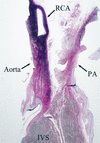Coronary artery anomalies--current clinical issues: definitions, classification, incidence, clinical relevance, and treatment guidelines
- PMID: 12484611
- PMCID: PMC140289
Coronary artery anomalies--current clinical issues: definitions, classification, incidence, clinical relevance, and treatment guidelines
Abstract
The study of coronary artery anomalies would benefit from the clarification of various fundamental issues, including the definitions, classification, incidence, pathophysiologic mechanisms, and clinical relevance of each anomaly. The greatest challenge is to identify the abnormality and determine its clinical relevance so that appropriate treatment can be instituted. Currently, the coronary anatomy is essentially defined by the features of the (conductive) epicardial coronary tree and its dependent territory. Therefore, one must consider all the possible and observed variations in anatomic features that are used to describe the coronary arteries. We propose that the left anterior descending, circumflex, and right coronary arteries be considered the essential elementary units of coronary anatomy. We also suggest that the coronary arteries be defined not by their origin or proximal course, but by their intermediate and distal segments or dependent microvascular bed. A strict classification system is necessary before meaningful data can be gathered about the incidence of coronary anomalies. With respect to clinical relevance, the greatest challenge is presented by anomalies that only occasionally cause critically severe clinical events and are otherwise compatible with a normal life. In such cases, it is not known whether the specific features of a given anomaly cause adverse clinical consequences, or whether additional episodic factors are required. To correlate subclassifiable anatomic and functional features with clinical events and prognoses, a large, multicenter database, relying on prospective, coordinated protocols, is urgently needed. In the absence of established official guidelines, we present practical protocols for diagnosing and treating coronary anomalies.
Figures





References
-
- Angelini P, Villason S, Chan AV Jr, Diez JG. Normal and anomalous coronary arteries in humans. In: Angelini P, editor. Coronary artery anomalies: a comprehensive approach. Philadelphia: Lippincott Williams & Wilkins; 1999. p. 27–150.
-
- Angelini P, de la Cruz MV, Valencia AM, Sanchez-Gomez C, Kearney DL, Sadowinski S, Real GR. Coronary arteries in transposition of the great arteries. Am J Cardiol 1994;74:1037–41. - PubMed
-
- Sans-Coma V, Duran AC, Fernandez B, Fernandez MC, Lopez D, Arque JM. Coronary artery anomalies and bicuspid aortic valve. In: Angelini P, editor. Coronary artery anomalies: a comprehensive approach. Philadelphia: Lippincott Williams & Wilkins; 1999. p. 17–25.
-
- Taylor AJ, Rogan KM, Virmani R. Sudden cardiac death associated with isolated congenital coronary artery anomalies. J Am Coll Cardiol 1992;20:640–7. - PubMed
-
- Virmani R, Burke AP, Farb A. The pathology of sudden cardiac death in athletes. In: Williams RA, editor. The athlete and heart disease: diagnosis, evaluation and management. Philadelphia: Lippincott Williams & Wilkins; 1999. p. 249–72.
Publication types
MeSH terms
LinkOut - more resources
Full Text Sources
